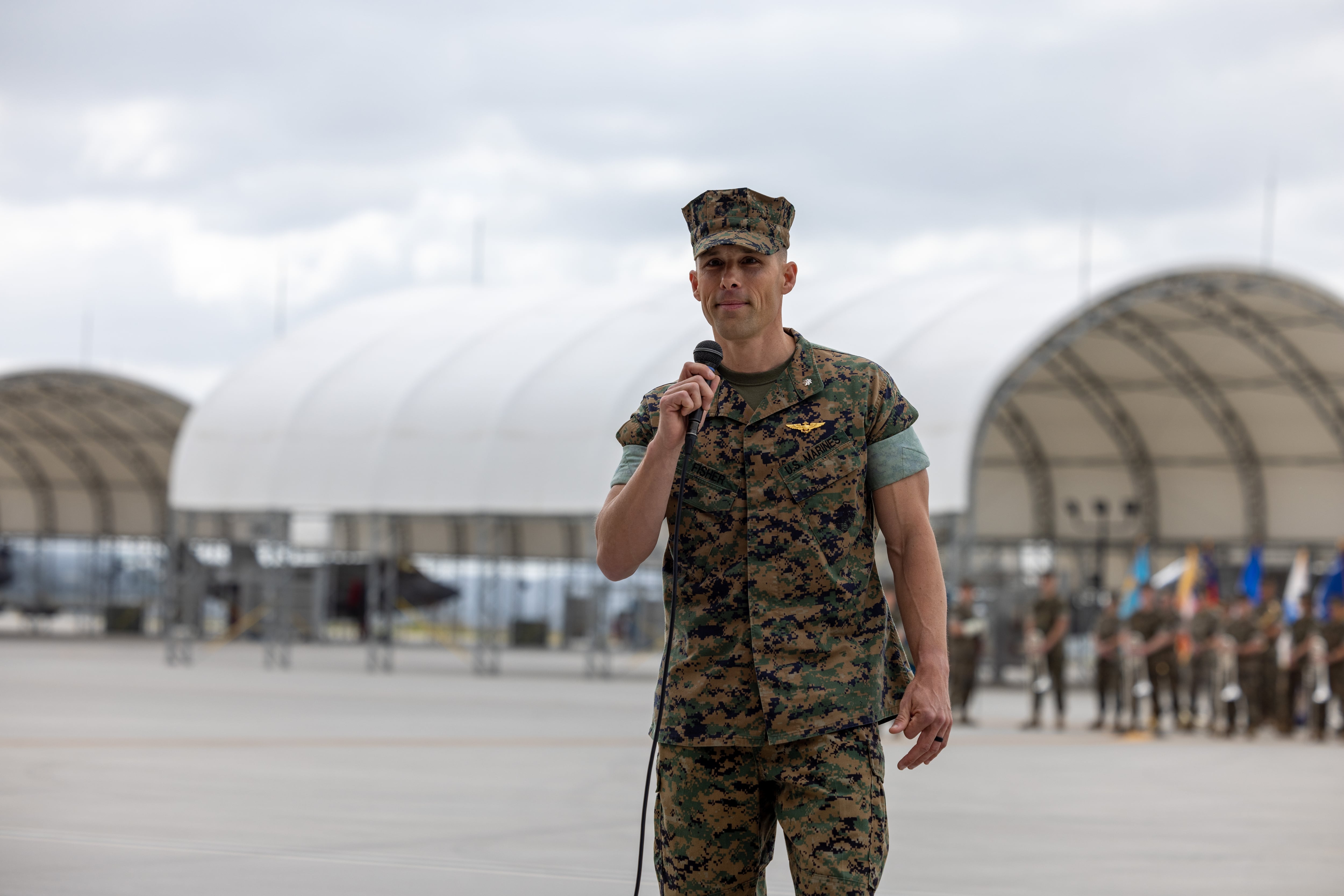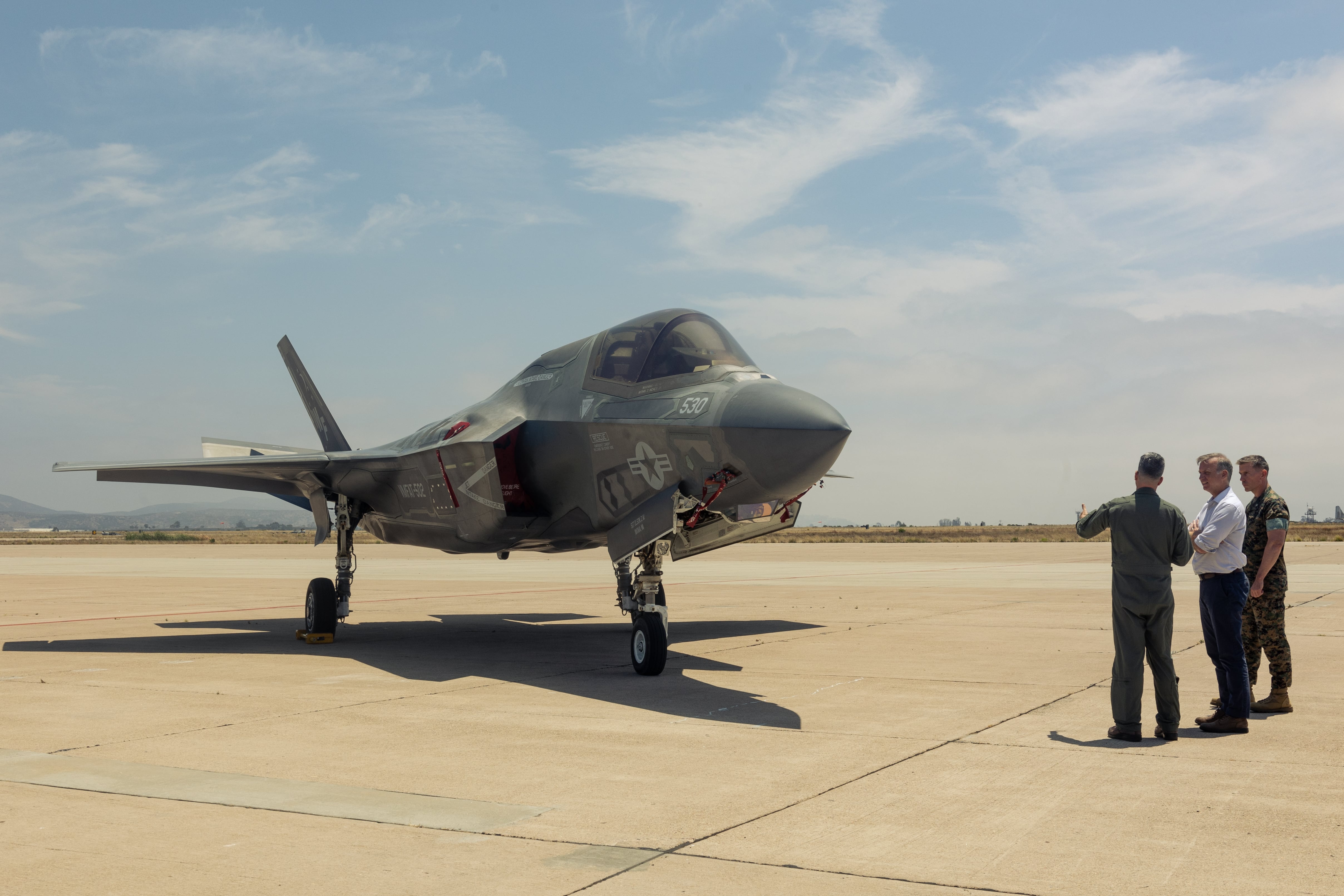Metal shavings in contaminated fuel, incorrectly assembled parts, and a plastic scraper protruding from a wing fold were among the faults discovered in five new F-35C Joint Strike Fighters delivered to a U.S. Marine Corps fighter squadron in California in 2023, according to a memo obtained by Defense News.
Marine Fighter Attack Squadron 311, or VMFA-311, at Marine Corps Air Station Miramar in San Diego discovered an array of problems with its Lockheed Martin-made F-35s that ultimately required more than 700 hours of work to fix and wasted more than 169,000 pounds of fuel, the Jan. 7 memo said.
On Dec. 7, for instance, a plastic scraper was discovered protruding from the wing fold of one of the squadron’s jets, after the jet had flown, the memo noted. The 5.5-inch scraper was discovered during a post-flight inspection on the jet and fell to the ground.
The F-35C is the Joint Strike Fighter variant flown by the Navy and Marine Corps, and each plane costs $94.4 million. It can take off from and land on aircraft carriers, and its wingtips are able to fold up to allow more compact storage on aircraft carriers.
The memo was written by VMFA-311 commander Lt. Col. Michael Fisher, who described a pattern of “persistent aircraft delivery discrepancies and premature component failures occurring at Marine Fighter Attack Squadron 311.” Fisher’s memo was approved by Col. William Mitchell, commander of Marine Aircraft Group 11.
“F-35 readiness continues to plague the Marine Corps and degrade our ability to be the nation’s stand-in force,” Fisher wrote. “The number of failed components, expended man-hours and lost sorties is unacceptable to maintain a baseline level of proficiency and consistency at the operational level. An F-35 ready room and maintenance department needs to believe in the quality and production of each F-35 aircraft.”

The severity and scope of the problems the memo described are “very surprising” and “frankly disturbing,” said Dan Grazier, a former analyst for the watchdog group Project on Government Oversight who specializes in defense programs.
Multiple flaws tallied
The quality problems and foreign object debris discovered in these five F-35s snarled the Marine Corps’ effort to stand up VMFA-311, nicknamed the Tomcats, as its second F-35C squadron. The jets had total flight hours ranging between 14 and 157, according to the memo, which was sent to the commanding general of the 3rd Marine Aircraft Wing, Maj. Gen. Michael Borgschulte.
The Marine Fighter Attack Squadron 311 was previously known as Marine Attack Squadron 311, which flew AV-8 Harriers, and the Corps redesignated it as an F-35C unit in April 2023. Then in September, the service declared the squadron “safe for flight,” meaning it had the necessary maintenance programs, processes and trained Marines on hand to be able to conduct flight operations.
But as the revamped squadron began to receive its new F-35Cs, it became apparent each had something wrong with them, according to the memo.
Marine Aircraft Group 11 received the F-35s directly from Lockheed Martin’s factory, and VMFA-311 then conducted acceptance inspections.
All five jets had fuel contaminated with Krytox, a high-temperature lubricating grease, the memo said, and three jets also had metal shavings in their fuel. The jets had to be defueled and refueled two or three times to get the fuel quality up to an acceptable level, with the jets that had metal shavings requiring an extra defueling cycle, the memo added.
Fisher, the VMFA-311 commander, wrote that this meant the squadron had to dispose of more than 169,000 pounds of contaminated fuel.
The seals and segments on multiple jets were not installed correctly, the memo said, and needed to be removed and reorganized.
And multiple parts in the jets — including power and thermal management system controllers, electronic units, and an electric-hydrostatic actuator on a jet’s trailing edge flap — failed, forcing the squadron to remove and replace them, the memo added.
One jet’s left main gear brake assembly also failed, another fighter’s panoramic cockpit display failed and yet another jet’s backup oxygen system bottle was leaking, the memo stated. All components also needed to be removed and replaced.
“This is not an all-inclusive list and other component failures have occurred since this report,” Fisher wrote.
In a statement to Defense News, Lockheed Martin said it is working closely with the Marine Corps, the government’s F-35 Joint Program Office and the Defense Contract Management Agency to address concerns raised in the memo.
“We take pride in the quality of the aircraft we deliver to customers around the world and assess all reported customer feedback on production quality and parts reliability,” the company’s statement said.
Lockheed Martin said it averages fewer than one missed production quality problem per F-35. The company said it closely monitors the reliability of F-35 parts and works with the joint program office to fix parts that fail early. Lockheed Martin also said parts on the F-35 typically last twice as long as those on fourth-generation jets.
The F-35 Joint Program Office declined to comment about the memo and VMFA-311′s F-35s, but said it takes steps to fix problems with new jets delivered to units.
“The JPO and DCMA have various means and teams that are engaged on a recurring basis with industry to evaluate and work corrective actions for quality issues that are reported from the field,” the office said.
Asked whether Lockheed Martin covers the costs of repairs or maintenance stemming from issues found in factory-delivered jets, the office said: “Costs of repairs or maintenance depend on the specific issue.”
The Marine Corps declined to speak to Defense News, saying it would not comment on documents that haven’t been officially released.
The 3rd Marine Aircraft Wing declined to comment on the maintenance issues described in the memo, citing operational security.
Fisher said that to make sure such problems are promptly fixed in the future, a direct communication line should be set up between the F-35 Joint Program Office and Lockheed Martin to those units accepting new F-35s, with responses coming no more than 24 hours after a unit reports a problem.
This needs to be in addition to and outside of the standard action request and occurrence reporting process already in place, he wrote, which “seldomly provides timely feedback or external assistance to repair gripes recorded by the accepting unit.”
Fisher also noted Lockheed Martin “should be accountable and responsible for aircraft discrepancies found during the unit’s acceptance process and functional flight check.” Furthermore, he explained, problems discovered with newly accepted aircraft, including premature component failures, need to be relayed across the entire F-35 fleet, including to other services and units.
Bloomberg in October reported another Marine Corps unit — Marine Fighter Attack Squadron 542 at Cherry Point, North Carolina — had to repair four F-35Bs shortly after arriving.
Grazier said it’s hard to tell whether the reported problems with new F-35s at VMFA-311 are simply a “bad batch” of problematic jets or a sign of a deeper problem.
“But the fact that all five of this squadron’s aircraft have shown up from the factory with problems like this — that certainly indicates a pattern,” Grazier said. “It should be addressed immediately.”
The problems — particularly the massive amounts of contaminated fuel that had to be disposed of — also represent a waste of taxpayer money and Marines’ time and effort, he added. Grazier said a program such as the F-35, which has been in the works since 2001, should have been able to work out such quality issues a long time ago.
“We’re still dealing with problems like this,” he added. “That’s not the way this process is supposed to work.”
Stephen Losey is the air warfare reporter for Defense News. He previously covered leadership and personnel issues at Air Force Times, and the Pentagon, special operations and air warfare at Military.com. He has traveled to the Middle East to cover U.S. Air Force operations.




